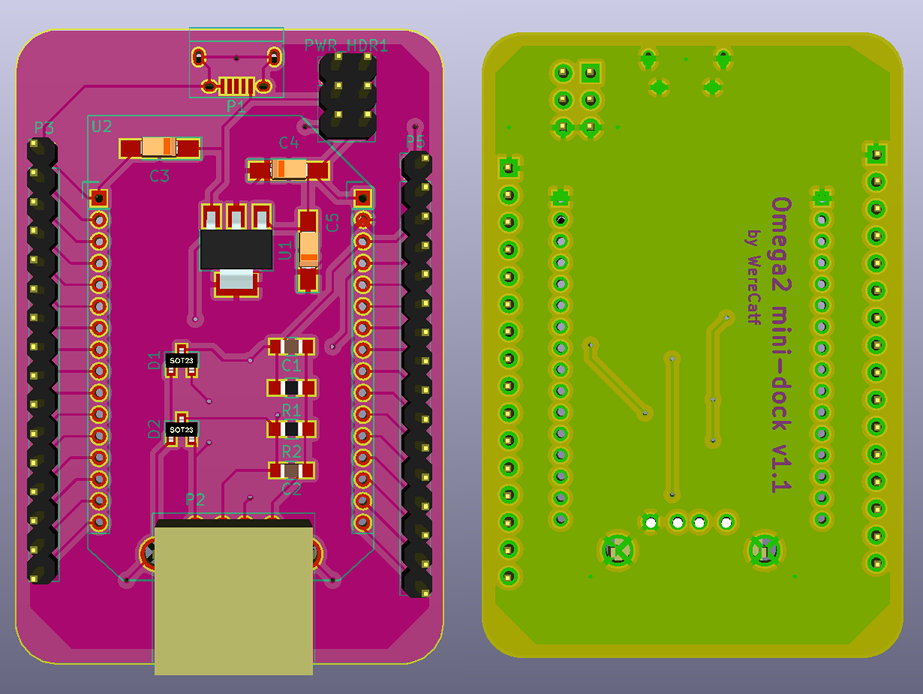DIY Onion-Mini-Dock
-
Hey guys, so I just got my Onion2+ but of course I forgot to buy the dock...
Because I am living in Germany, I think it will be faster and cooler if I develop my own open-hardware onion-dock.Looking on the schematics of the dock from https://github.com/OnionIoT/Onion-Hardware/blob/master/Schematics/Omega-Mini-Dock.pdf I wonder how important is the component Q1 as I am thinking in having it always on while the micro-usb is connected.
Second questions, could anyone suggest a component for items D12, D13 and D14?
I will use this thread to show the progress.
Cheers

-
Looks like those diodes are "transient-voltage-suppression diodes", and are used to clamp down on electrostatic discharge from frying the rest of the circuit.
As for the transistor, you could probably do without it (though I don't claim to be any sort of expert) and just have the regulator connected directly to the power bus through a switch.
I'm going to be doing something similar, but I just got a cheap CP2102 breakout board on amazon (they generally come with 3V3 output, so no need even to connect through the regulator) to save myself the hassle.
-
Thanks, but I believe that the AO3401 is also not really necessary, right?
I am almost done with the project, then I will share it here for you to take a look.
-
@Daniel-Andrade I would agree that I don't think the A03401 is really needed.
You might also like to consider the use of a
TSR 1-2433in place of theBL1117-3.3
TheTSR 1-2433will give you a regualated 3.3v from any input supply in the range 4.75 – 36 VDC
But I would highly recommend that you still use suitable capacitors across the input and output. See sample circuits in the datasheet for theTSR-1series which can be found at https://cdn-shop.adafruit.com/datasheets/tsr1.pdf
-
Hey, right now the project looks like this:
Schematics and extra docs here:
http://www.danielandrade.net/onion/onion_dock_v0.1.pdfFor 3v3 regulator, I am using a TLV1117LV33DCYR from Texas.
Don't really need so much power from the Traco.Any extra tips and ideas?
Thanks!!!
-
@Daniel-Andrade It's an excellent idea to have the Omega pins available for customized use, and on standard headers to boot.

-
@fossette Yes, I want it to be Breadboard friendly!
-
@Daniel-Andrade Cool. So basically a form of Mini dock with all the pins exposed for breadboarding/external connections. Great

-
This is great! I thought of doing something like this myself, but yours is much more capable. I want one!
-
Just sent the first board to production.
Going to CES and taking some holidays. I will be back in mid-january.If everything works I will post here and I can send them to anyone with production + shipping cost

-
@Daniel-Andrade Please do. I'd be interested!
-
Also see https://community.onion.io/topic/1338/new-omega2-basic-shield-power-ftdi-i2c-and-spi for something very similar
-
@Daniel-Andrade any news on your boards?
-
@Costas-Costas @Daniel-Andrade I too would be most interested in any updates on availability of this. Thanks
-
@Daniel-Andrade hope it will be available in Brazil too ...
-
Ist the micro usb acts as USB host or client? I think you should add USB host connector...
-
@Victor-Tagayun The schematics show the microUSB-port is simply connected to a CP2102 USB-TTL-adapter. It's not connected to the Omega2 itself.
-
I've never made a single PCB before, let alone used Kicad, but after tussling with it for a day I managed to do my own take on a mini-dock. I skipped on the USB-TTL, because I am going to be using an external one anyways, if needed, nor do I need those reset-buttons, but I did decide to include ESD-protection on the USB-port's data-lines. I also added a header with a couple of extra power-pins, either for powering the device from, or to power any external modules I may want to connect to it.

-
@WereCatf Nice to have another dock option! So, the Omega mounts over the header socket?
-
@Ken-Conrad No, I figured it'd just about fit under the Omega2, when I solder the female 2.0mm headers, but then I just simply forgot to actually measure it.